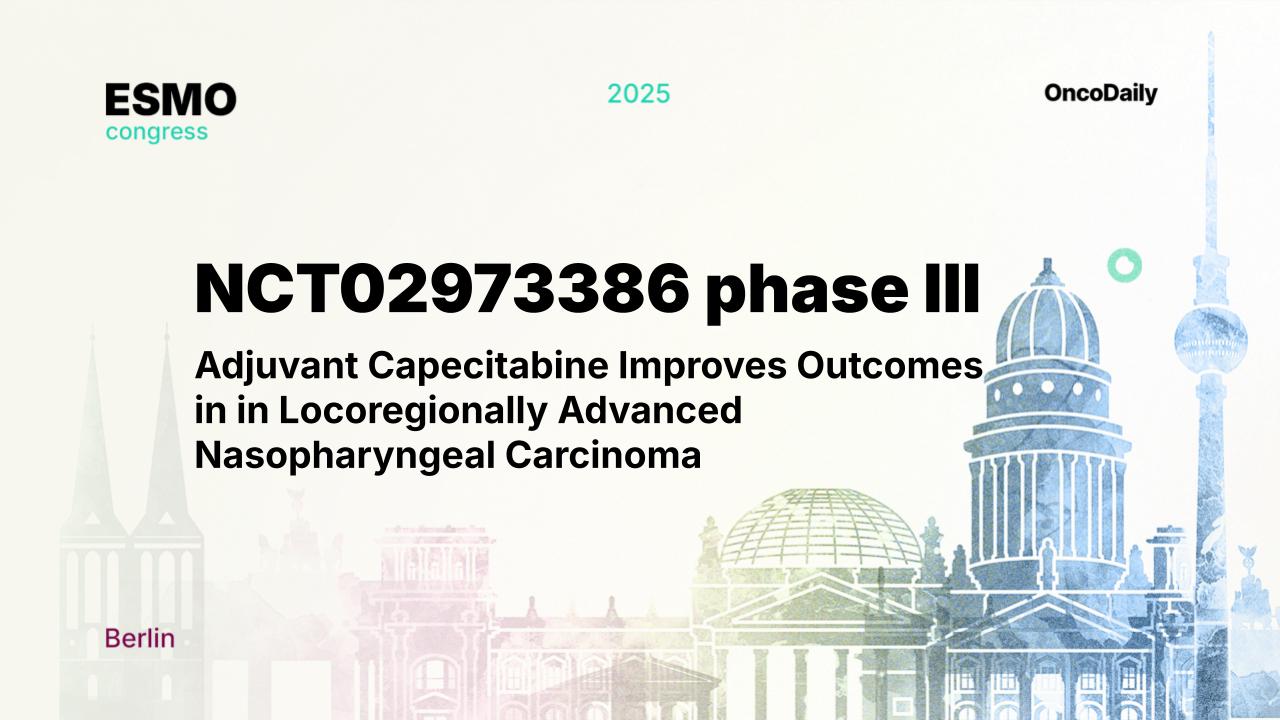At ESMO 2025, Jingjing Miao presented this randomized phase III study (NCT02973386) during Proffered Paper Session 2 — Head & neck cancer, outlining how adding adjuvant capecitabine after standard concurrent cisplatin–radiotherapy (CCRT) impacts long-term outcomes in locoregionally advanced nasopharyngeal carcinoma (LANPC).
Background
CCRT is the standard backbone for LANPC, yet distant relapse remains a major cause of failure. Capecitabine is a convenient oral fluoropyrimidine with radiosensitizing and cytotoxic activity. This trial tested whether CCRT followed by adjuvant capecitabine (AC) improves outcomes versus CCRT alone.
Methods
Eligible patients had newly diagnosed, non-keratinizing NPC, stage III–IVb (AJCC/UICC 8th; T3N0 excluded). Participants were randomized 1:1 to:
CCRT → AC: Cisplatin 100 mg/m² every 3 weeks for 2–3 cycles, plus IMRT (prescriptions: 70–72 Gy PTVnx; 64–70 Gy PTVnd; 60–66 Gy high-risk; 54–58 Gy low-risk in 30–35 fractions), followed by capecitabine 1000 mg/m² twice daily, days 1–14 every 21 days ×8 cycles.
CCRT alone: Same cisplatin and IMRT without adjuvant therapy.
The primary endpoint was 5-year distant metastasis-free survival (DMFS); key secondary endpoints included overall survival (OS), failure-free survival (FFS), local relapse-free survival (LRFS), regional relapse-free survival (RRFS), and safety.
Results
From March 2017 to October 2022, 294 patients were enrolled (147 per arm). All completed RT and ≥2 cisplatin cycles (cumulative cisplatin 200 mg/m² in both arms). In the experimental arm, 97.3% (143/147) started AC and 86.4% (127/147) completed all 8 cycles; 18.2% required AC dose reduction. Median follow-up was 62.1 months.
Efficacy (intention-to-treat):
Primary endpoint — 5-year DMFS: 89.5% with CCRT→AC vs 81.6% with CCRT alone (HR 0.50, 95% CI 0.27–0.92; p=0.030).
5-year OS: 96.4% vs 87.8% (HR 0.28, 95% CI 0.12–0.64).
5-year FFS: 85.3% vs 76.8% (HR 0.56, 95% CI 0.33–0.97).
5-year LRFS: 95.8% vs 84.2% (HR 0.27, 95% CI 0.13–0.56).
5-year RRFS: 93.2% vs 83.7% (HR 0.41, 95% CI 0.21–0.80).
Safety
Capecitabine-related ≥grade 1 events included anemia 60.1%, leukopenia 47.6%, hand–foot syndrome 44.1%. Grade 3–4 capecitabine-related events were infrequent: neutropenia 3.5%, hand–foot syndrome 2.8%, leukopenia 1.4%. Overall tolerability was favorable, with no unexpected signals.
Conclusions
In LANPC, adjuvant capecitabine after standard CCRT significantly improves 5-year DMFS and confers broad survival gains (OS, FFS, LRFS, RRFS) versus CCRT alone, with manageable toxicity. These data support CCRT followed by capecitabine as a compelling strategy to reduce distant failure and enhance long-term outcomes.
You can read the full abstract here.
